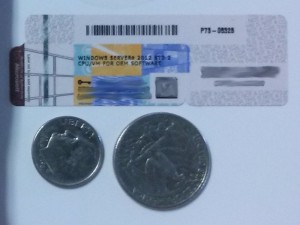This is mostly intended for myself… but if it helps you, you’re welcome.
Exchange 2007/2010 with Outlook 2007 clients is a hellkitten to get right, and I do not say this affectionately. Â You need to get RPC over HTTP working, or the Out-Of-Office Assistant will not work, and neither will the offline Address Book (or, very likely, the GAL).
In order to get RPC over HTTP working, you must have several virtual directories running right in IIS, you must have client certificates ignored on those virtual directories, you must have both Basic AND Integrated authentication on those directories, and you must have a proper SSL certificate on the site. Â On a standard Exchange setup, this will be the (Default Web Site). Â On an SBS setup, this will be the (SBS Web Applications) site.
Definition of “proper” SSL certificate: you must have both the internal domain name AND any external domain names ON THE SAME CERT. Â If your internal domain is “domain.local” or something like that, this probably means you’re going to have to use self-signed certs (and deal with security warnings on clients outside the local domain). Â If you have an FQDN, you ought to be able to get everything on one UCC certificate… you will need, at a minimum, internaldomain.com, mail.internaldomain.com, externaldomain.com, and mail.externaldomain.com. Â If possible, you also want autodiscover.externaldomain.com and autodiscover.internal.com, but they aren’t strictly necessary.
Here are some incredibly brief tips toward finagling the virtual directories and the certificates. Â Except where specified otherwise, these are all commandlets run from the Exchange Management Shell – there is very little you can or should be doing from the Exchange Management Console for working with these issues.
Testing from Outlook:
control-right-click the Outlook icon in the system tray, and you will have options for “Connection Status…” and “Test E-Mail Autoconfiguration…” available.  Your ultimate goal here is to get the “Test E-Mail Autoconfiguration…” option working.  If you DON’T get this working, you’re not going to have a fully functional Exchange setup, regardless of what anything in the “Connection Status…” tells you.  To get this working, you will need to have either mail.yourdommainname.com or autodiscover.yourdomainname.com both in DNS and on the SSL certificate bound to the site in IIS which hosts the virtual directories for Available Services, the OAB, UM, and OWA.  If you specified both internalurls and externalurls in your virtual directory setup, both of them need to work properly from inside the domain or local clients will not work; you can’t really control whether they decide to use the internalurl or the externalurl, and in my experience, they will frequently choose to use the externalurl, even if they’re plugged into the same switch and sitting physically right next to the Exchange server.
If your “Testing Autoconfiguration…” comes up with failures, you’ve got problems with your certificates, your virtual directories, your settings for URLs to your virtual directories, or all three… head to the tips below to examine and troubleshoot.
A word of warning about the Exchange Management Shell:
The EMS commandlets sometimes use Uri and sometimes use Url for their argument names… so be careful; even though they both mean the same thing, you have to get the right arbitrary spelling for the right arbitrary commandlets.  (Thanks for that, Microsoft…)
Another word of warning about the EMS:
you can get away with using all lower case for the commandlets themselves, but argument names for the commandlets require CamelCase as shown in the examples below.
A third and final word of warning about the EMS:
The examples I’ve shown below are extremely terse, and assume that, once pointed to examples of working usage, you can figure out the gist of what they mean, what they do, and likely useful ways to do related things just from seeing the syntax shown. Â If you don’t feel comfortably that this is the case, then for the love of working systems stop right now and hire a (more experienced) professional!
And now, on to the actual EMS usages:
test basic RPC proxy connectivity:
rpcping -t ncacn_http -s servername -o RpcProxy=proxyservername -P "user,domain,pass" -I "user,domain,pass" -H 2 -u 10 -a connect -F 3 -v 3 -E -R none
test RPC proxy through to Information Store default port on back-end:
rpcping -t ncacn_http -s servername -o RpcProxy=proxyservername -P "user,domain,pass" -I "user,domain,pass" -H 1 -F 3 -a connect -u 10 -v 3 -e 6001
test RPC proxy through to IS backend default port using Mutual auth:
RpcPing –t ncacn_http –s ExchangeMBXServer  -o RpcProxy=RpcProxyServer -P "user,domain,password" -I "user,domain,password" -H 1 –F 3 –a connect –u 10 –v 3 –e 6001 –B msstd:server_certificate_subject
test all web services:
Test-OutlookWebServices
setting the Exchange cert: (note that not all services may be installed)
enable-ExchangeCertificate -thumbprint "thumbprintfromcert" -services "IIS,IMAP,POP,SMTP,UM"
if private key is missing: get serial number from cert and…
certutil -repairstore my "serialnumberfromcert"
Autodiscover:
Get-ClientAccessServer | Select Name, *Internal* | fl
Set-ClientAccessServer -Identity servername -AutoDiscoverServiceInternalUri: https://mydomain.com/Autodiscover/Autodiscover.xml
OAB:
in EMS, Server Configuration -> Client Access -> select server in top window -> click Offline Address Book Distribution tab in bottom window -> click OAB properties in right window, under Actions; set internal and external URLs from there
Web Services:
Get-WebServicesVirtualDirectory | Select name, *url* | fl
Set-WebServicesVirtualDirectory –Identity “<EWS Name>†–InternalUrl: https://url.domain.local/EWS/Exchange.asmx
Unified Messaging:
Get-UMVirtualDirectory | Select Name, *url* | fl
Set-UMVirtualDirectory –Identity: “<UM Virtual Directory>†–InternalURL: <URL/UnifiedMessaging/Service.asmx>
